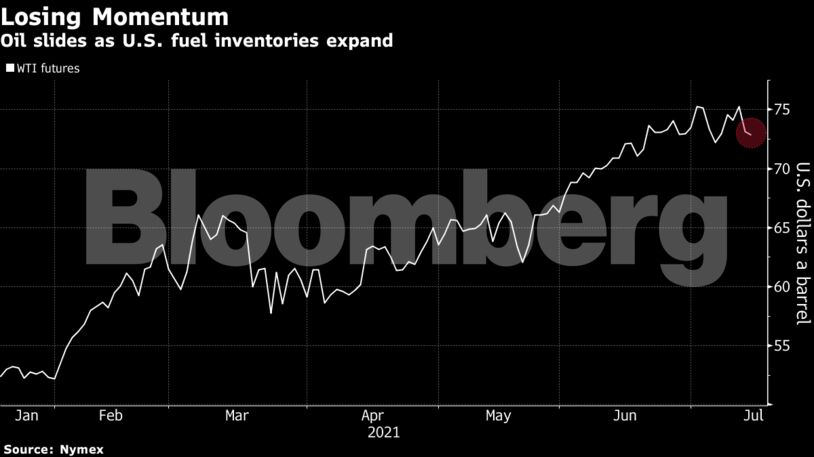There were also signs OPEC+ may be able to revive supplies soon, as delegates said United Arab Emirates made significant progress in resolving its standoff with Saudi Arabia. A deal is taking shape that would give the UAE a more generous output limit next year, and allow the group to restore halted production.
Oil has rallied more than 50% this year as the vaccine rollout lifts demand in major economies such as the U.S. and China, and fosters a recovery in Europe. Futures prices are still showing a premium on nearer-term contracts, known as backwardation, which usually indicates tightness. But there are risks to the recovery amid the spread of the highly-transmissible delta variant of the virus.
“On the demand side of the oil balance, the running amok of the delta variant of the coronavirus causes headaches among investors,” said Tamas Varga, an analyst at PVM Oil Associates Ltd. in London. “This certainly hinders economic growth that might have a negative impact on the demand recovery.”
In the U.S., gasoline stockpiles rose by more than 1 million barrels last week, EIA data showed on Wednesday. A Bloomberg survey had forecast a 2-million barrel draw. Distillate inventories climbed by about 3.7 million barrels, more than expected, while crude supplies declined by 7.9 million barrels. As a result, the backwardation for yearly spreads between December contracts has come under pressure.
| Prices |
|---|
|
Traders are watching closely to see whether the OPEC+ coalition calls another meeting to resolve the bitter dispute between Saudi Arabia and the UAE that broke out earlier this month.
While the two countries were closing in on an agreement to revise Abu Dhabi’s production quota, it would still need to be ratified by the whole group before they could salvage plans to revive halted oil production. Goldman Sachs Group Inc. said an accord would be a “bullish catalyst,” and would help remove the low risk of a potential price war.
See also: Oil Set to Top $80 on Tight Market Despite Any OPEC+ Deal: Citi
The 23-nation OPEC+ block had intended to restore about 5.8 million barrels of offline production capacity — still idled since the pandemic emerged last year — in monthly tranches of 400,000 barrels a day. The International Energy Agency on Tuesday warned that the market would tighten significantly if the alliance didn’t add more barrels.
Still, the two sides haven’t fully resolved their differences and talks are ongoing. There are signs other members of the alliance have been inspired to air their own grievances, with Iraq now seeking a higher baseline for its cuts.
| Other market news: |
|---|
|
Share This:




 CDN NEWS |
CDN NEWS |  US NEWS
US NEWS 





























COMMENTARY: Busting Biases, Boosting Innovation – Geoffrey Cann